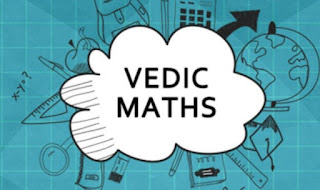VEDIC MATHS-36
VEDIC MATHS
By OMKAR TENDOLKAR
This is post number 36 from the series of "Vedic maths" blogs. Here in this blog we will learn about "Concept of Base Method for Squaring and example".
We have seen Base Method of multiplication in our previous blog. There is a corollary of the Base Method called the ‘Yavadunam’ rule. This rule is helpful in squaring numbers.
In this blog we will study the Yavadunam rule and its applications in squaring numbers.
RULE:
Swamiji had coined the Yavadunam rule in a Sanskrit line. When translated into English, it means:
‘Whatever the extent of its deficiency, lessen it to the same extent and also set up the square of the deficiency.’
We thus see that the answer is composed of two parts:
- In first part of answer we add given number to the deficiency ( deviation from the Base) which form LHS of the answer.
- In the second part, we square the deficiency which form RHS of the answer.
(While writing the answer we will put the first part on the LHS and the second part on the RHS)
Examples:
1) Find the square of 8
8 -2
- The Base is nearest power of 10. Here in this example given number i.e. 8 is closure to 10 itself so we take base as 10.
- In the first part, we add given number i.e. 8 with the deficiency -2 it gives ( 8 +(- 2)) = 6 Put it in LHS.
- In the second part, we square the deficiency. The square of 2 is 4 and hence we put it on the RHS.
- The final answer is 64.
Thus, the square of 8 is 64.
(Since the Yavadunam rule is a corollary of the Base Method, the method used in this rule is exactly similar to the Base Method)
2) Find the square of 988
9 8 8 -1 2
- The Base is nearest power of 10. Here in this example given number i.e. 988 is closure to 1000, so we take base as 1000.
- In the first part, we add 988 with the deficiency -12 it gives (988 + (- 12)) = 976 Put it in LHS.
- In the second part, we square the deficiency. The square of -12 is 144 and hence we put it on the RHS.
- The final answer is 976144.
Thus, the square of 988 is 976144.
3) Find the square of 97
9 7 -3
- The Base is nearest power of 10. Here in this example given number i.e. 97 is closure to 100, so we take base as 100.
- In the first part, 97 with the deficiency -3 it gives ( 97 + (- 3)) = 94 Put it in LHS.
- In the second part, we square the deficiency. The square of -3 is 9 but we write it as 09 (because base has two zero) hence we put it on the RHS.
- The final answer is 9409.
Thus, the square of 97 is 9409.
4) Find the square of 14
1 4 4
- The Base is nearest power of 10. Here in this example given number i.e. 14 is closure to 10 itself so we take base as 10.
- In the first part, 14 with the deviation 4 it gives ( 14 + (4)) = 18 Put it in LHS.
- In the second part, we square the deficiency. The square of 4 is 16 but we write it as 16 hence we put it on the RHS.
- We have observed in the previous blog that if the base is 10, the RHS can be a single digit answer only. In this case, it is a two-digit answer, namely, 16. Hence, we carry over the extra digit 1 to LHS and add it to 18 so it becomes 19.
- The final answer is 196.
Thus, the square of 14 is 196.
Find Square of following:
1. ( 93)^2 = 8649
2. (108)^2 = 11664
3. (9985 )^2 = 99700225
The simplicity of this method can be vouched from examples given above
.
You may try following example:
1. (96)^2
2. (104)^2
3. (9997)^2
You may answer this in comment box. You may ask your any query or doubt in comment box. I will try to resolve as early as possible.
In next blog we will discuss about "Digit-Sum Method".
Are you excited for this?...
Then, please wait for it.
I will post my new blog in next week.
We will meet very soon through our next blog. Till that stay connected, stay healthy and stay safe.
Thanks
for giving your valuable time.
Good day😊.


Comments
Post a Comment